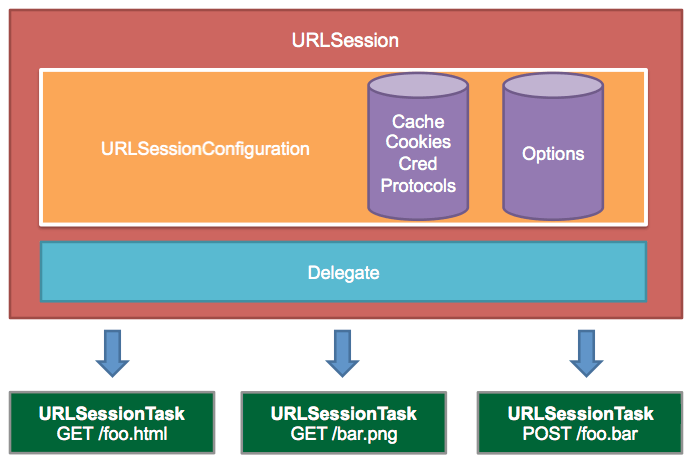Optimization
Multipath TCP
Multipath TCP improves the performance of your app when a user is in a location with limited Wi-Fi and while their device is transitioning to and from cellular data usage. In its default configuration, a URL session uses a single radio for a network call, preferring Wi-Fi over cellular. However, with Multipath TCP enabled, the URL session initiates the request on both radios and selects the more responsive of the two with a preference for Wi-Fi.
TCP Fast Open
https://www.nanog.org/sites/default/files/Paasch_Network_Support.pdf
Transport Layer Security (TLS) 1.3 Improved security Reduced connection setup time
Securing Communications on iOS https://code.tutsplus.com/articles/securing-communications-on-ios--cms-28529
URLRequests And URLSessions
URLSession is technically both a class and a suite of classes for handling HTTP/HTTPS-based requests:

URLSessionConfiguration
URLSession is the key object responsible for sending and receiving HTTP requests. You create it via URLSessionConfiguration, which comes in three flavors:
.default: Creates a default configuration object that uses the disk-persisted global cache, credential and cookie storage objects.
.ephemeral: Similar to the default configuration, except that all session-related data is stored in memory. Think of this as a “private” session.
.background: Lets the session perform upload or download tasks in the background. Transfers continue even when the app itself is suspended or terminated by the system.
URLSessionConfiguration also lets you configure session properties such as timeout values, caching policies and additional HTTP headers
URLSessionTask
URLSessionTask is an abstract class that denotes a task object. A session creates one or more tasks to do the actual work of fetching data and downloading or uploading files.
There are three types of concrete session tasks:
- URLSessionDataTask: Use this task for HTTP GET requests to retrieve data from servers to memory.
- URLSessionUploadTask: Use this task to upload a file from disk to a web service, typically via a HTTP POST or PUT method.
- URLSessionDownloadTask: Use this task to download a file from a remote service to a temporary file location.
The default request method is GET. If you want a data task to POST, PUT or DELETE, create a URLRequest with the url, set the request’s HTTPMethod property appropriately, then create a data task with the URLRequest, instead of with the URL.
URL Encoding (Percent Encoding)
- Since URLs often contain characters outside the ASCII set, the URL has to be converted into a valid ASCII format.
- URL encoding replaces unsafe ASCII characters with a "%" followed by two hexadecimal digits.
- URLs cannot contain spaces. URL encoding normally replaces a space with a plus (+) sign or with %20.
GET Request
var getURL = URL(string: "https://httpbin.org/get?bar=foo")!
var getRequest = URLRequest(url: getURL, cachePolicy: .useProtocolCachePolicy, timeoutInterval: 30.0)
//getRequest.httpMethod = "GET"
getRequest.setValue("application/json", forHTTPHeaderField: "Content-Type")
getRequest.setValue("application/json", forHTTPHeaderField: "Accept")
URLSession.shared.dataTask(with: getRequest, completionHandler: { (data, response, error) -> Void in
if error != nil { print("GET Request: Communication error: \(error!)") }
if data != nil {
do {
let resultObject = try JSONSerialization.jsonObject(with: data!, options: [])
DispatchQueue.main.async(execute: {
print("Results from GET https://httpbin.org/get?bar=foo :\n\(resultObject)") })
} catch {
DispatchQueue.main.async(execute: {
print("Unable to parse JSON response")
})
}
} else {
DispatchQueue.main.async(execute: {
print("Received empty response.")
})
}
}).resume()
POST Request
var postURL = URL(string: "https://httpbin.org/post?param1=value1")!
var postRequest = URLRequest(url: postURL, cachePolicy: .reloadIgnoringCacheData, timeoutInterval: 60.0)
postRequest.httpMethod = "POST"
postRequest.setValue("application/json", forHTTPHeaderField: "Content-Type")
postRequest.setValue("application/json", forHTTPHeaderField: "Accept")
let parameters: [String: Any] = ["foo": "bar", "numbers": [1, 2, 3, 4, 5]]
do {
let jsonParams = try JSONSerialization.data(withJSONObject: parameters, options: [])
postRequest.httpBody = jsonParams
} catch { print("Error: unable to add parameters to POST request.")}
URLSession.shared.dataTask(with: postRequest, completionHandler: { (data, response, error) -> Void in
if error != nil { print("POST Request: Communication error: \(error!)") }
if data != nil {
do {
let resultObject = try JSONSerialization.jsonObject(with: data!, options: [])
DispatchQueue.main.async(execute: {
print("Results from POST https://httpbin.org/post :\n\(resultObject)")
})
} catch {
DispatchQueue.main.async(execute: {
print("Unable to parse JSON response")
})
}
} else {
DispatchQueue.main.async(execute: {
print("Received empty response.")
})
}
}).resume()
Network Layer
https://medium.com/@danielemargutti/network-layers-in-swift-7fc5628ff789
https://www.raywenderlich.com/177991/updated-course-networking-urlsession-2